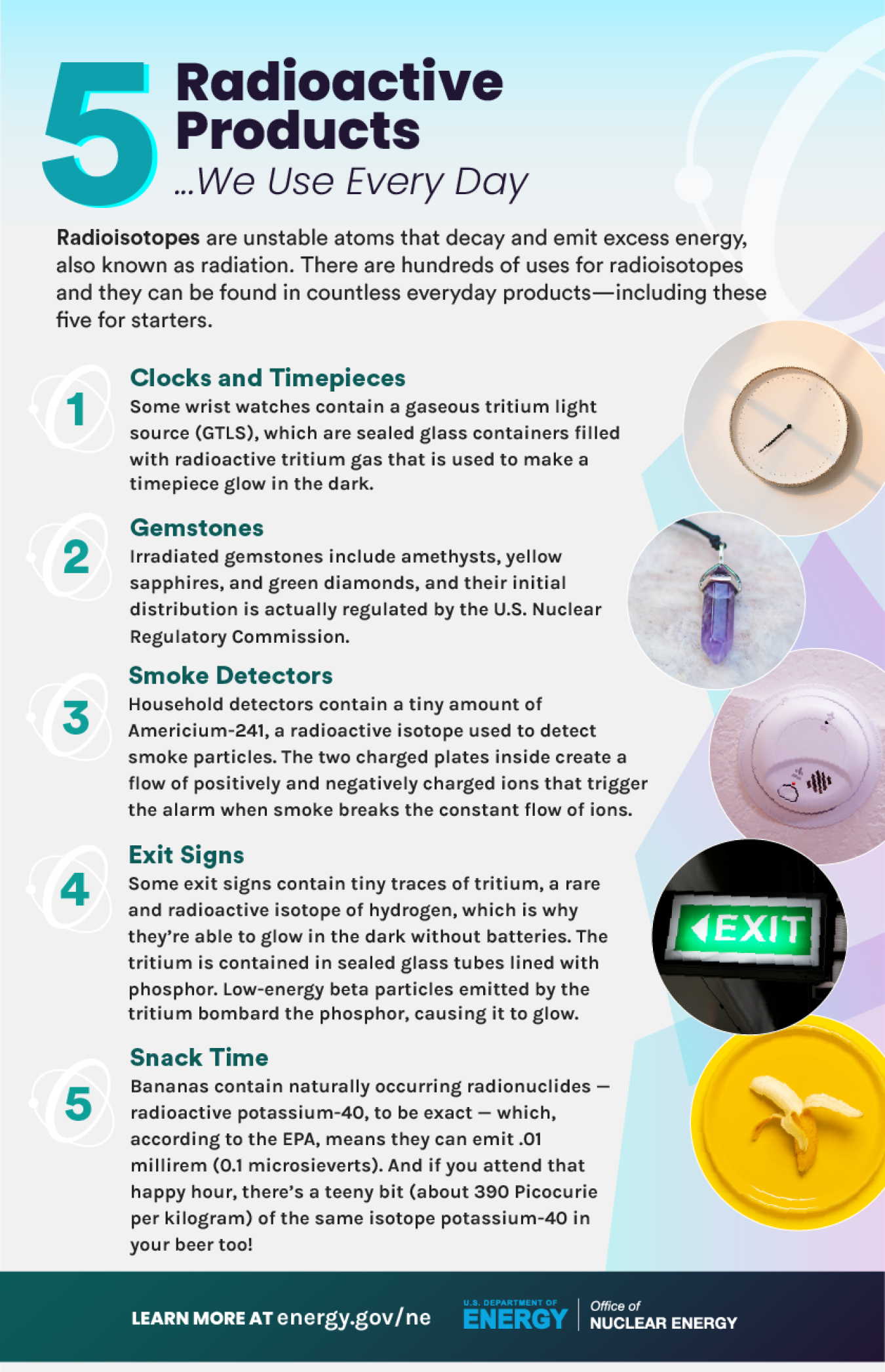Radioisotopes have hundreds of uses and can be found in countless everyday products — including these five for starters.
September 12, 2023Bananas are a health snack that are also slightly radioactive thanks to naturally occurring radionuclides such as potassium-40.
Nuclear energy powers our lives in different ways.
It helps us explore the galaxy, diagnose and treat diseases, solve criminal investigation cases, and power our grid as the largest source of clean energy in the U.S.
And while all of that is incredible, did you know there are several items found at home and in the office that we use daily that also use radioactive materials?
These items do all sorts of things – from keeping you on time for your appointments to literally saving your life.
Radioactive Isotopes 101
First, let’s talk radioisotopes.
These are simply unstable atoms that decay and emit excess energy (also known as radiation). They can be naturally occurring or artificial isotopes of an element.
You might be familiar with medical radioisotopes, which have been used to treat an array of medical conditions since the 1940s, or perhaps you’ve heard of the radioisotope power systems that have powered more than two dozen NASA space missions.
Radioisotopes have hundreds of uses and can be found in countless everyday products — including these five for starters.
Clocks and Timepieces
When it comes to telling time, precision counts.
The National Institute of Standards and Technology’s (NIST) atomic clock is considered the world’s most accurate timekeeping instrument.
Some wrist watches contain a gaseous tritium light source (GTLS), which are sealed glass containers filled with radioactive tritium gas that is used to make a timepiece glow in the dark.
Gemstones
Adorn yourself with jewelry?
Your precious gems might credit their brilliance to radiation in the form of gamma, neutron, or electron beams that are used to modify and enhance their color.
Irradiated gemstones include amethysts, yellow sapphires, and green diamonds, and their initial distribution is actually regulated by the U.S. Nuclear Regulatory Commission (NRC).
The NRC requires the stones to be set aside for a few months before they can be put on the market.
Distributors must conduct radiological surveys on the gems before they can be sold to the public to ensure the radioactivity is below levels that would pose any health risk.
Smoke Detectors
Some consider the smoke alarm to be the greatest fire safety success story of the 20th century, and it’s powered partly by radioactive materials.
According to NIST, the risk of dying in reported home structure fires is 55% lower in homes with working smoke alarms than in homes with no alarms or none that worked.
Many household detectors contain a tiny amount of Americium-241, a radioactive isotope used to detect smoke particles. The two charged plates inside create a flow of positively and negatively charged ions that trigger the alarm when smoke breaks the constant flow of ions.
Fun fact: the smoke detector was discovered by accident in the 1960s. Consider this your reminder to make sure the batteries in your smoke detector are working!
Exit Signs
By law, exit signs must be installed throughout every commercial building in the U.S. in case of an emergency.
But did you know that some of these signs contain tiny traces of tritium, a rare and radioactive isotope of hydrogen?
This is how they’re able to glow in the dark without batteries. (Yes, like wrist watches.)
The tritium is contained in sealed glass tubes lined with phosphor. Low-energy beta particles emitted by the tritium bombard the phosphor, causing it to glow.
Fun fact: Self-luminous signs provide a quick path to safety during power outages for up to 20 years before they need to be replaced.
Snack Time
Reaching for a banana in the supermarket produce aisle will give you more than just a healthy dose of potassium.
That’s right, bananas contain naturally occurring radionuclides — radioactive potassium-40, to be exact — which, according to the EPA, means they can emit .01 millirem (0.1 microsieverts).
So, eating a banana actually presents more radiation exposure than if you were standing next to a spent nuclear fuel dry cask or nuclear power plant!
But don’t go bananas! While the fruit is indeed radioactive, the dose of radioactivity they deliver is miniscule and does not pose a health risk.
By the way, if you’re attending post-work happy hour, there’s a teeny bit (about 390 Picocurie per kilogram) of the same isotope potassium-40 in your beer, too.
The Future of Nuclear in Tech
A company called NDB Inc. is partnering with Oak Ridge National Laboratory and others on nuclear energy-powered batteries that could revolutionize smartphones and make charging ports obsolete.
According to the company, these batteries “could potentially last dozens, hundreds, or even thousands of years, and they would generate their own power from radiation.”
Not to mention they would prevent the batteries used today from winding up in landfills.
So next time you check your watch or change the batteries in your smoke detector, think about the marvels of nuclear technology that make it possible!


